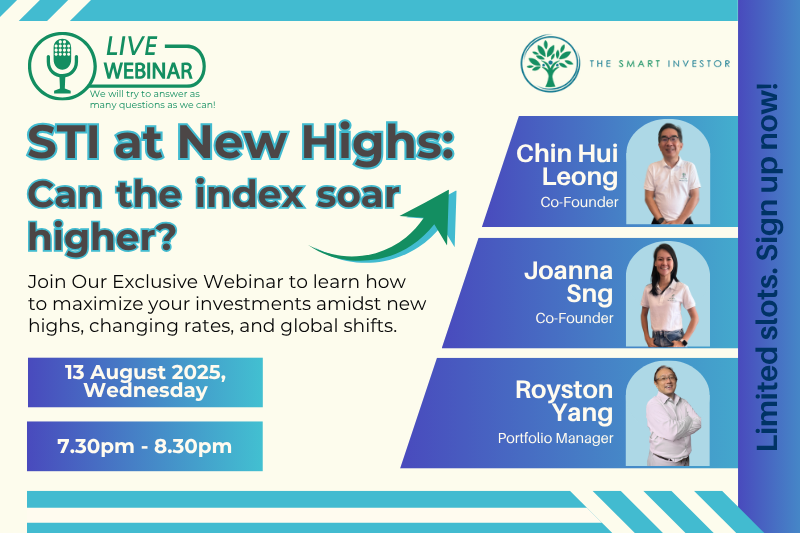Every investor is familiar with this feeling.
You purchase a blue-chip stock, watch it rise, decide to lock in profits by selling – only to watch it climb even higher months later.
One of the most frequent and costly mistakes in long-term investing is selling winners too soon.
Since the market crash during the 2020 pandemic and recent interest rates volatility, Singapore’s blue-chip stocks have repeatedly shown that patience rewards those who hold on.
Why Investors Sell Too Soon
Emotional triggers, such as those stemming from the fear of losing profits or short-term pessimism, often drive premature selling.
Another reason for premature selling occurs when investors focus on timing rather than time in the market – when anxiety driven by market noise overrides rational decision-making.
This is supported by behavioral finance research.
Meir Statman has extensively documented how cognitive and emotional factors drive investor decision-making, often leading to premature selling.
Morningstar’s 2025 “Mind the Gap” study shows that poor timing of trades typically erodes returns: the average dollar invested in US mutual funds and ETFs earned 7.0% per year over the past decade, compared to the 8.2% that those same funds returned – a gap of 1.2 percentage points per year.
The gap widens for more actively traded funds: those with the most volatile cash flows capture nearly two percentage points less return annually than funds with stable cash flows.
For example, during the COVID-19 pandemic, DBS Group Holdings (SGX:D05) plummeted below S$16 in March 2020.
Investors who sold in fear missed the subsequent rally to doubling to over S$32 by November 2022, along with the bank’s dividends.
Singapore Exchange (SGX:S68) saw a similar pattern.
The bourse operator’s share price fell to around S$7.60 during the March 2020 sell-off, only to recover steadily to above S$10.50 by mid-2021 as trading volumes normalised and investor confidence returned.
Both companies have consistently demonstrated that blue-chip pullbacks are temporary, but recoveries are long-lasting.
These two examples clearly illustrate how short-term fear leads investors to abandon positions just before the real gains begin.
The Power of Compounding Dividends
Selling too early doesn’t just forfeit capital gains – it also cuts short the powerful compounding effect of growing dividend income.
Consider DBS again, which has paid S$2.85 in dividends per share over the trailing twelve months, translating to a 5.3% yield at the current share price of S$53.70.
Management remains committed to growing dividends as the bank sustains its target 15-17% return on equity, with additional capital return programs planned.
Here’s why holding matters: imagine you bought DBS shares at S$20 in early 2020 when it was paying around S$1.20 annually.
Today, your yield on your original S$20 cost has climbed to 14.3%, while someone buying today at S$53.70 earns just 5.3%.
This growing income stream compounds alongside capital appreciation, but only if you hold long enough to capture it.
Blue-chips like DBS and SGX steadily grow payouts over time, enhancing total returns.
Market Timing Rarely Works
Panic-selling during bad news almost always means missing the recovery.
Even experienced investors struggle to time market peaks and troughs with any consistency.
Many of the most notable market recoveries have occurred immediately following the steepest declines.
During the 2008 Global Financial Crisis, the Straits Times Index (SGX: ^STI) dipped to 1,456 points on 9 March 2009, then surged 127% past 3,300 by 8 November 2010, just 20 months later.
These three Singapore blue-chip stocks similarly rebounded during an 20-month window of the GFC recovery, measured from the market low of March 2009 to the end of November 2010:
| Stock | Low Price (Close) | Date of Low | High Price (Close) | Date of High | Calculated Gain |
| DBS (SGX: D05) | S$5.86 | 9 Mar 2009 | S$14.16 | 27 Apr 2010 | +141.6% |
| OCBC (SGX: O39) | S$3.83 | 9 Mar 2009 | S$9.94 | 11 Nov 2010 | +159.5% |
| CICT (SGX: C38U) | S$0.98 | 12 Mar 2009 | S$2.15 | 30 Sep 2010 | +119.4% |
Investors who sold during the crisis missed wealth-creating returns that often materialise in just months, not years.
These instances emphasise a fundamental reality: markets consistently reward those who stay invested through volatility rather than those who try to trade around it.
The Strength of Blue-Chip Businesses
Blue chip companies thrive as industry leaders because they combine financial strength, pricing power, and diversified revenue streams that weather economic storms.
Take DBS during the pandemic.
While the global economy contracted sharply in 2020, the bank maintained a robust CET1 ratio of 13.9% and delivered S$4.72 billion in net profit – demonstrating the resilience investors pay for when buying quality franchises.
Another well-known firm that has continually demonstrated strength is Singapore Technologies Engineering (SGX: S63).
In 1H2025, ST Engineering reported a 7% year-on-year (YoY) increase in revenue to S$5.92 billion, and net profit of S$403 million (up 20% YoY).
Despite headwinds in certain divisions, ST Engineering’s earnings remain fairly steady owing to its diversified portfolio across aerospace, defence, and smart city innovations.
Strong balance sheets, consistent earnings, and competitive moats let these companies navigate downturns while funding growth and dividends.
For long-term holders, volatility creates opportunities rather than crises.
When It Is Time to Sell
Patience doesn’t mean holding forever.
Even blue chips deserve scrutiny, and sometimes selling is the right decision – if it’s based on deteriorating business fundamentals rather than short-term price movements or market anxiety.
Legitimate reasons to sell include weakening earnings, dividend cuts or suspension, rising leverage, broken business model, or when valuations become unsustainably high.
You could lose out on potential profits if you sell simply because the stock price has gone up.
A good example is Keppel Corp (SGX: BN4).
Keppel posted a net income of S$431 million in 1H2025, representing a 25% rise from the previous year, as funds under management (FUM) grew to S$91 billion.
The stock rose 29.8% from S$6.87 on 2 January 2025 to S$8.92 on 30 September 2025 as investors recognised the company’s successful transformation.
Selling after an early 15% gain would have meant missing the move – and the improving fundamentals driving it.
The lesson: base decisions on business performance, not price movements or emotions.
What This Means for Investors
Often, doing less rather than more yields the best outcomes.
The winning strategy isn’t complicated: buy quality blue chips with strong balance sheets, consistent earnings, and growing dividends, then hold through both calm and turbulent markets.
Singapore’s blue chips reward this discipline.
Each demonstrates that business quality compounds over time, but only if you hold long enough to capture it.
Get Smart: Let Time Work for You
Great enterprises accumulate wealth gradually – if you let them.
Experienced investors resist kneejerk reactions on every price movement, and instead give their best holdings the time they need to compound and grow.
Wealth comes from owning great businesses long enough for time to work.
Patience isn’t passive – it’s the most disciplined strategy available.
Imagine a life where steady income flows, no matter the market. Our new free report, “Retire Early with Dividends,” reveals how. We’ve pinpointed 5 dependable Singapore dividend stocks that offer a proven, stress-free path to financial freedom. Stop just dreaming and start building your early retirement plan today. Your free guide awaits here.
Follow us on Facebook, Instagram and Telegram for the latest investing news and analyses!
Disclosure: Joseph does not own shares in any of the companies mentioned.





